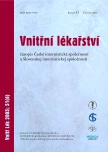Acute masive pulmonary embolism – indication for surgical thromboembolectomy
Authors:
A. Mokráček 1; M. Vambera 2; M. Šulda 1; M. Šetina 1; F. Toušek 2
Authors‘ workplace:
Kardiochirurgické oddělení Nemocnice České Budějovice, přednosta prim. MUDr. Marek Šetina, CSc.
1; Kardiologické oddělení Nemocnice České Budějovice, přednosta prim. MUDr. František Toušek
2
Published in:
Vnitř Lék 2005; 51(6): 734-739
Category:
Case Reports
Overview
The authors report the case of 63-year-old man with hypertension admitted to heart center with extreme respiratory distress, cyanosis, somnolence and manifestations of acute cor pulmonale. His admission was preceded by one-month history of worsening of dyspnea peaking on day before admission by a presyncopic state. Ultrasound demonstrated a freely rotating thrombus in the right atrium, massive pulmonary embolism with a big thrombus in the right pulmonary artery, foramen ovale patens and severe right ventricular dysfunction. Within 90 minutes of admission, the patient in a critical circulatory state, was connected to extracorporeal circulation. A surgeon removed a long thrombus from the righ atrium, performed endarterectomy and thrombectomy of both pulmonary artery branches and closed foramen ovale patens. Following twelve days hospitalisation, the patient, in the stable condition and receiving anticoagulation with warfarin, was transferred to an internal department to fully recover. In the discussion section, the authors review current indication and the philosophy of surgical pulmonary thrombectomy.
Key words:
pulmonary embolism – thrombembolectomy
Sources
1. Aklog L, Williams CS, Goldhaber SZ. Acute pulmonary trombectomy: a contemporary approach. Circulation 2002; 105 : 1416–1419.
2. British thoracic society standard of care committee pulmonary embolism guideline developement group. Thorax 2003; 58 : 470–483.
3. Doerge H, Schoendube FA, Voss M et al. Surgical therapy of fulminant pulmonary embolism: an early results. Thorac Cardiovasc Surg 1999; 47 : 9–13.
4. Goldhaber SZ, Elliot CG. Acute pulmonary embolism: Part I Epidemiology, Pathophysiology, and Diagnosis. Circulation 2003; 108 : 2726–2729.
5. Goldhaber SZ, Elliot CG. Acute Pulmonary Embolism: Part II Rissk Stratification, Treatment and Prevention. Circulation 2003; 108 : 2834–2838.
6. Goldhaber SZ, Visani L, De Rosa M. Acute Pulmonary Embolism: Clinical Outcomes. Lancet 1999; 353 : 1386–1389.
7. Gray HH, Morgan JM, Paneth M et al. Pulmonary embolectomy for massive pulmonary embolism – analysis of 71 cases. Br Heart J 1988; 60 : 196–200.
8. Grifoni S, Olivotto I, Cecchini H et al. Short-term clinical outocome of patients with acute pulmonary embolism, normal blood pressure, and echocardiographic right ventricular dysfunction. Circulation 2000; 101 : 2817–2822.
9. Gulba DC, Schmid C, Borst H et al. Medical compared with surgical treatment for massive pulmonary embolism. Lancet 1994; 343 : 576–577.
10. Koning R, Cribier A, Gerber L et al. A new fragment of severe pulmonary embolism. Circulation 1997; 96 : 2498–2500.
11. Konstantinides S, Geibel A, Olschewski M et al. Importance of cardiac troponins I and T in risk stratification of patients with acute pulmonary embolism. Circulation 2003; 106 : 1263–1268.
12. Kvasnička J. Trombofilie a trombotické stavy v klinické praxi. Praha: Grada Publishing 2003 : 33–59.
13. Laas J, Schmid C, Albes JM et al. Surgical aspects of fulminant pulmonary embolism. Z Kardiol 1993; 82(Suppl 2): 25–28.
14. Lapostolle F, Surget V, Borron SW. Severe pulmonary embolism associated with air travel. N Engl J Med 2001; 345 : 779–783.
15. Meyer G, Tamisier D, Sors H et al. Pulmonary embolectomy: a 20-year experience at one center. Ann Thorac Surg 1991; 51 : 232–236.
16. Prandoni P, Bilora F, Marchiori A. An association between atherosclerosis and thrombosis. N Engl J Med 2003; 348 : 1435–1441.
17. Reekers JA, Baarslag HJ, Koolen MGJ et al. Mechanical trombectomy for treatment massive pulmonary embolism. Cardiovasc Intervent Radiol 2003; 26 : 246–250.
18. Riedel M. Choroby plicního oběhu. Praha: Galén 2000 : 169–172.
19. Riedel M, Rudolph W. Hamodynamik und Gasustausch bei akuter Lungenembolie. Herz 1989; 14 : 109–114.
20. Rossouw JE, Anderson GV, Prentice RL. Risk and benefits of estrogen plus progestin in healthy postmenopausal women. JAMA 2002; 288 : 321–333.
21. Schulman S, Lindmarker P. Incidence of cancer after prophylaxis with warfarin agains recurrent venous tromboembolism. N Engl J Med 2000; 342 : 1953–1958.
22. Task Force on Pulmonary Embolism, European Society of Cardiology. Diagnosis and Management of Acute Pulmonary Embolism. Eur Heart J 2000; 21 : 1301–1336.
23. Vandenbroucke JP, Rosing J, Blomenkamp KW. Oral contraceptives and the risk of venous thrombosis. N Engl J Med 2001; 344 : 1527–1535.
24. Widimský J, Malý J. Akutní plicní embolie a žilní trombóza. Praha: Triton 2002 : 137–173, 181–185.
25. Widimský J. Stratifikace rizika akutní plicní embolie. Cor Vasa 2004; 46 : 379–383.
26. Špatenka J. Chirurgická embolektomie. In: Akutní plicní embolie a žilní trombóza. Praha: Triton 2002, 181–184.
27. Yalamanchili K, Fleisher GA, Lehrman GS et al. Open Pumonary emboectomy for Treatment of Major Pulmonary Embolism. Ann Thorac Surg 2004; 77 : 819–823.
Labels
Diabetology Endocrinology Internal medicineArticle was published in
Internal Medicine

2005 Issue 6
Most read in this issue
- Esophageal achalasia
- B-type natriuretic peptide (BNP) – application in differential diagnosis of dyspnoea
- Practice guidelines for diagnosis and therapy of essential thrombocytaemia and thrombocytaemia associated with other myeloproliferative diseases
- Disorders of iron metabolism I. Regulation of iron homeostasis
